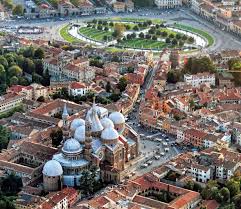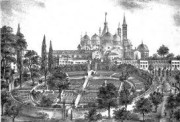Brief City’s History
According to the legend, Padua was founded in 1132 BC, on the banks of the river Brenta by Antenor, a Trojan Prince escaped from the Trojan war. Nobody knows whether this is true or not, but certainly some archaeological discoveries have determined its origin to about 1400 B.C. . Padua is therefore the most ancient City of the Venetian Region. In ancient times it was inhabited by the people called the ancient Venetians. In 226 a. C. Padova allied with Rome, and along with it, fought some battles, like the one against the Gauls; later he became a Roman town and became also part of the Regio X (one of the 11 territories in which Italy was divided by Emperor Augustus), getting rich through the wool working and its trade. In the period of the barbarian invasions it was sacked by the Huns, Lombards and Hungarians. During the Middle Ages Padua became a free city, going against the Emperor Frederick Barbarossa.The Carraresi Lordship dominated the City from 1318 AD for about a century, until it was conquered from Venice that ruled for four centuries, bringing stability and affluence .In 1300 aD Padua became one of the Italian capitals of culture and art, also thanks to the famous painter Giotto. In the Renaissance, under the Lordship of the Carraresi, Padua influenced the fifteenth-century art, and became also the seat of one of the oldest University of the World. The City was also a Episcopal seat and is now known as the City of the Saint, in honor of the Portuguese Franciscan friar Sant ‘Antonio from Padua, who lived a few years in the City and there died. In 1797 d. C the City passed to Napoleon, who gave it to the Austrians of the Habsburg Lombardo-Veneto kingdom. In 1866 aD Padua became part of the Kingdom of Italy, after the third war of independence won against the Austrians.
The City
Padua is an important City, medium sized, with a little more than 200,000 inhabitants. The City is crossed by some canals and waterways, such as rivers Brenta and Bacchiglione, that make it very suggestive. The greenery abounds in Padova, making it a really pleasant place where to live. The climate is typical of the Po Valley, cold during the winter and the sultry in summer. Its history makes it a very important cultural center, with the second oldest University in Italy, dating back to 1222 A.D., where also the famous scientist Galileo Galilei taught, and the highest concentration of Medieval frescoes (Giotto, Mantegna, Giusto, Altichiero and Guariento) kept in Churches and Palaces. Another peculiarity of Padova is its 12 kilometers of arcades, that allow you to wander around its center without getting wet in the rain or snow. In recent decades the it has expanded and in its suburbs many modern buildings and a large industrial area have been built.
Places to see
1. Palazzo della Ragione: it was a previous ancient building dating to the Roman period, on which later, in 1218 AD, the ancient seat of city courts was built. The upper floor of the building has a wonderful hall of huge size (81 meters x 27 meters, with a height of 27 meters) decorated by beautiful paintings, with astrological theme, dating back to 1425 AD, which replaced those of Giotto, destroyed in 1420 AD in a fire. On the sides of the hall there are the two famous squares of Padua’s markets: Herbs Square and Fruit’s Square. Below the hall there are some traditional food shops.
2. Basilica di Santa Maria Assunta or Cathedral of Padua: it is the main place of worship in Padua , in baroque-mannerist style, built on the ruins of the previous Romanesque era Churches from 1522 AD to 1754 AD, when it was consecrated by Cardinal Rezzonico.
3. Cappella degli Scrovegni: within it there is what is considered the most complete cicle of frescos of the great master Giotto at his best. In this simple, rectangular Chapel with the barrel vault, there are the frescos by Giotto, completed in 1306 AD, depicting events of the lives of Gioacchino and Anna, of Mary and Jesus and the allegories of Vices and Virtues.
4. The Equestrian Monument dedicated to Gattamelata: it is an imposing bronze statue, the first large equestrian statue cast from ancient times, situated in Piazza del Santo in Padua. Created by Donatello in honor of the warlord of the Venetian Republic Erasmo da Narni, known as Gattamelata, it dates back to the period between 1446 and 1453 AD.
5. Palazzo Zabarella: ancient Palace of pre-Roman times, it has turned several times over the years, but still keeping its ancient atmosphere. Today seat of important art exhibitions, international in scope, and cultural events.
6. Eremitani Museum: the Museum Complex, the most ancient in the whole Veneto, houses the Archaeological Museum, the Museum of Medieval and Modern Art and the Scrovegni Chapel. The Archaeological Museum houses many Paleovenetian, pre-Roman and Roman artefacts, in addition to an interesting Egyptian section. The Museum of Medieval and Modern Art preserves unique Masterpieces, made from ‘300 AD to 800 AD, as the Crucifix by Giotto and paintings by Tintoretto, Veronese, Tiepolo, and many others.
7. Piazza dei Signori, Piazza della Frutta and Piazza delle Erbe: all dated back to pre-Roman Age , they are the three most celebrated Squares among the many present in the historical center of Padua. Piazza della Frutta and Piazza delle Erbe are dominated by the imposing Palazzo della Ragione and they house one of the largest markets of Italy; while Piazza dei Signori, itself home to a market , has always had lower commercial propensity than the other two, having been the site par excellence of the City’s celebrations
8. Arena Gardens: charming public Park, in an area that goes from Corso Garibaldi to Via Porciglia. On the inside it’s possible to admire the ruins of the Arena, an ancient Roman theater, built around 70 d.C, the Scrovegni Chapel, built between 1303 and 1305, and the Eremitani Complex.
9. Prato della Valle: it is the largest Square of the City and among the largest in Italy and Europe, with a total area of 88,620 sqm. Because of its huge dimensions, it was, in ancient times, often used for military trainings. Its present form: a central, ovoid, large area of about 20,000 square meters surrounded by a small canal with a double ring of statues on its banks, dates from the late eighteenth century.






